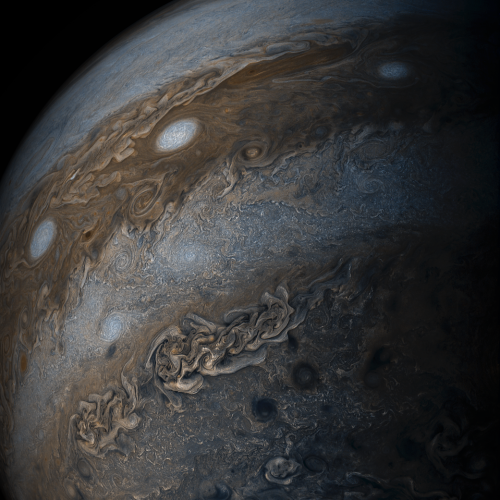Your gateway to endless inspiration
Imageoftheday - Blog Posts
Our Most “Liked” Instagram Posts of 2017
Our Instagram page has over 2,200 images and is lucky enough to be followed by more than 29 million fans.
What images and videos were your favorite from this past year? Great question, and one we asked ourselves too!
Here’s a look at our most liked Instagram posts* of 2017…Enjoy!
#10 Black Hole Collision

What happens when two supermassive black holes collide? Until last year, we weren’t quite sure. Gravitational waves! With 834,169 likes, this image is our 10th most liked of 2017.
#9 Italy Through the Space Station Cupola Window

European astronaut Paolo Nespoli (@Astro_Paolo) shared this image on social media of "Southern #Italy and Sicily framed by one of our Cupola windows" aboard the International Space Station. This image ranks #9 for 2017 with 847,365 likes.
#8 Black Hole Friday

For our 5th annual #BlackHoleFriday we’ll share awesome images and facts about black holes! A black hole is a place in space where gravity pulls so much that even light cannot get out. With 916,247 likes, this picture ranks #8 for 2017.
#7 The Elements of Cassiopeia A

Did you know that stellar explosions and their remains--“supernova remnants”--are a source of chemical elements essential for life here on Earth? A new Chandra X-ray Observatory image captures the location of several vital elements like silicon (red), sulfur (yellow), calcium (green) and iron (purple), located on Cassiopeia A--a supernova remnant ~11,000 light years from Earth. This image ranks #7 for 2017 with 943,806 likes.
#6 Jupiter Blues

Jupiter, you’re bluetiful 💙 ! Churning swirls of Jupiter’s clouds are seen in striking shades of blue in this new view taken by our Juno spacecraft. This image ranks as our sixth most liked Instagram post of 2017 with 990,944 likes.
#5 An Interstellar Visitor

An interstellar visitor…scientists have confirmed that an intriguing asteroid that zipped through our solar system in October is the first confirmed object from another star! Observations suggest that this unusual object had been wandering through the Milky Way, unattached to any star system, for hundreds of millions of years before its chance encounter with our star system. With 1,015,721 likes, this image ranks #5 for 2017.
#4 Space Station Lunar Transit

Space station supermoon. This composite image made from six frames shows the International Space Station, with a crew of six onboard, as it transits the Moon at roughly five miles per second on Dec. 2. This image ranks #4 for 2017 with 1,037,520 likes.
#3 The Space Between Us
A post shared by NASA (@nasa) on Dec 20, 2017 at 2:56pm PST
The beautiful space between Earth and the International Space Station was immortalized by NASA astronaut Mark Vande Hei while orbiting 250 miles above the planet we call home. This majestic image ranks #3 for 2017 with 1,042,403 likes.
#2 The Moon Swallows the Sun
A post shared by NASA (@nasa) on Aug 21, 2017 at 2:03pm PDT
Today, the Sun disappeared, seemingly swallowed by our Moon–at least for a while. The August 21 solar eclipse cut through a swath of North America from coast to coast and those along the path of totality, that is where the Moon completely covered the Sun, were faced with a sight unseen in the U.S. in 99 years. Which might have something to do with this image ranking #2 for 2017 with 1,144,503 likes.
#1 Solar Eclipse Over Cascade Lake
A post shared by NASA (@nasa) on Aug 21, 2017 at 3:57pm PDT
Behold! This progression of the partial solar eclipse took place over Ross Lake, in Northern Cascades National Park, Washington on Monday, Aug. 21, 2017.
This photo was our #1 image of 2017 with 1,471,114 likes!
See them all here!
Do you want to get amazing images of Earth from space, see distant galaxies and more on Instagram? Of course you do! Follow us: https://www.instagram.com/nasa/
*Posts and rankings are were taken as of Dec. 28, 2017.
Make sure to follow us on Tumblr for your regular dose of space: http://nasa.tumblr.com.

Swirling bands of light and dark clouds on Jupiter are seen in this image made by citizen scientists using data from our Juno spacecraft. Each of the alternating light and dark atmospheric bands in this image is wider than Earth, and each rages around Jupiter at hundreds of miles (km) per hour. The lighter areas are regions where gas is rising, and the darker bands are regions where gas is sinking. This image was acquired on May 19, 2017 from about 20,800 miles (33,400km) above Jupiter's cloud tops. Learn more
Credits: NASA/JPL-Caltech/SwRI/MSSS/Gerald Eichstädt /Seán Doran
Make sure to follow us on Tumblr for your regular dose of space: http://nasa.tumblr.com